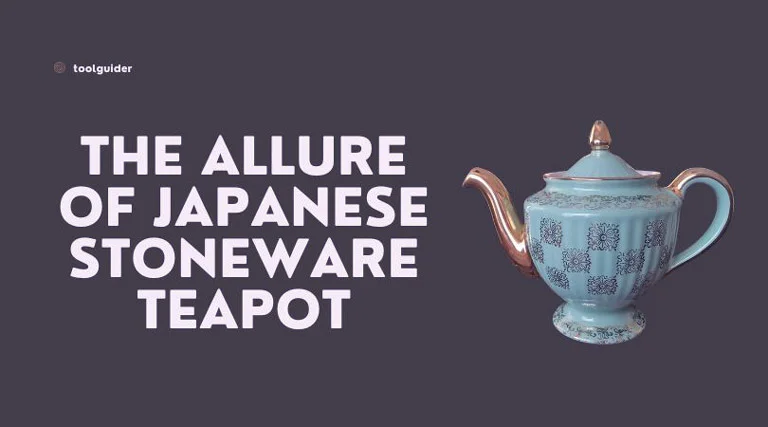Japanese stoneware teapots are more commonly known as Yokode Kyusu. They are exquisite works of art, lovingly handcrafted by skilled artisans who infuse each piece with their creativity and dedication.
Their unique traits makes them a testament to their excellence as teaware. With their durability, heat retention, rustic aesthetics, and cultural significance, these teapots enrich the tea-drinking experience.
Handcrafted Excellence
One of the hallmark traits of Japanese stoneware teapots is their rustic and earthy appearance. The texture and glaze often vary, giving each teapot a distinctive character and an inviting, down-to-earth charm.
Whether you are brewing tea for yourself or sharing it with others, Japanese stoneware teapots elevate the ritual of tea, connecting you with the timeless artistry and tradition of Japan’s tea culture. Japanese stoneware teapots, celebrated for their durability and rustic elegance, are treasured tea companions that deserve special care to ensure their longevity and continued beauty.
Characteristics of Japanese Stoneware Teapots
Stoneware teapots are made from a specific type of clay that has exceptional strength and resilience. Stoneware is an excellent heat retainer, meaning that the tea brewed within these teapots remains hot for a long time. This feature is particularly advantageous when preparing teas requiring higher water temperatures.
In keeping with the principles of functional design, stoneware teapots feature well-crafted handles that makes pouring easy and comfortable. The spouts are carefully crafted to minimize spills and guarantee a controlled flow of tea. The lids of stoneware teapots are designed to fit snugly, aiding in the retention of heat during the brewing process.
Maintenance of Your Japanese Stoneware Teapot
Proper maintenance will not only keep it in good shape but also enhances their aesthetic appeal. Rinse the teapot with plain, warm water after each use. It will help to remove residual tea and prevents any buildup of flavors.
If you encounter stubborn stains or tea residue, use a soft sponge or cloth to gently scrub the interior. Avoid using metal brushes or harsh scrubbers that may scratch the surface. After cleaning or use, ensure that the teapot is completely dry. Leaving it with moisture inside can contribute to rust formation.
Never place your stoneware teapot directly on a stovetop or open flame. Stoneware is not designed for stovetop use and can crack when exposed to direct heat. It is sensitive to sudden temperature changes. Avoid pouring hot tea into a cold teapot or vice versa, as this can lead to cracks.
Setting Your Preferences
Japanese stoneware teapots are versatile and can accommodate a wide range of teas, including black, green, oolong, and herbal. However, some tea enthusiasts prefer using specific teapots for particular tea types to enhance flavor.
Determine if you want brew tea for yourself only or if you enjoy sharing tea with others. Teapot sizes can vary, and choosing the right size ensures you have the right amount of tea for your intended audience.
Take in consideration its unique texture and glaze of your Japanese stoneware teapot. Each teapot is different, and selecting one that resonates with your aesthetic preferences can enhance your overall tea experience.
Wrap up
Japanese stoneware teapot represent a combination of form and function. Their strength, heat-retaining properties, and inviting aesthetic make them cherished companions for tea enthusiasts and collectors alike.
By considering your personal preferences and customizing your Japanese stoneware teapot, you can create a tea-drinking ritual that is uniquely your own. Your teapot becomes more than a functional vessel; it becomes a cherished companion on your journey of tea exploration and enjoyment.
FAQ
Japanese cast iron teapots, also known as Tetsubin, are generally safe to use. It is made from pure cast iron which is non toxic. High quality teapots have an extra layer of enamel and ceramic coating to not form rust. Japanese cast iron teapots can be safe for use when used properly and maintained regularly. The development of rust is normal over time but can be managed through proper care and maintenance.
japanese ceramics can withstand the microwave’s heat without any issues. Ensure that the ceramic is plain and does not have metallic patterns, decals, or decorations. Always use microwave-safe dishes, even when heating plain ceramics, to prevent overheating or uneven heating. Use microwave-safe covers or lids to prevent splatters and spills.
Ceramic teapots are delicate and not heat resistant. They are fragile and prone to cracking, warping, or discoloration when exposed to direct heat. Stovetop heating is uneven, and the direct contact with a heating element can create hot spots, which can lead to thermal stress and cracking in the teapot.
stoneware Teapots are designed for brewing tea by steeping tea leaves or bags in hot water, not for boiling water. Stovetop heating is uneven, and direct contact with a heating element can create hot spots in the teapot, potentially causing thermal stress and cracking. These teapots are used for steeping and serving tea, not for heating water or other liquids on a stovetop.
Japanese pottery, including traditional ceramics like porcelain and stoneware, can contain lead, especially in the glazes or decorative elements. Some older or traditional Japanese pottery may have been glazed with lead-based glazes. Contemporary Japanese pottery produced for culinary and dining purposes is generally lead-free and adheres to safety regulations.

I love all things tech, and I wear many hats – tech lover, business starter, digital marketer, and blogger. I know the ins and outs of Digital Marketing, SEO, SEM, SMM, and how to generate leads. My goal? Making things simple for you with clear guides and reviews. I stumbled upon WordPress while creating my first business site, and I fell in love with it right away. When I’m not building websites, creating content, or boosting clients’ online efforts, I’m focused on staying healthy, hanging out with family, and exploring the world. Connect with me on Facebook, Twitter, Linkedin, or read my complete biography.


